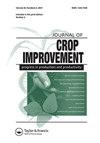Genetic diversity and relationships among populations of jackfruit, an underutilized nutrient-rich climate-smart fruit tree crop in Kenya and Uganda
IF 1.5
Q3 AGRONOMY
引用次数: 2
Abstract
ABSTRACT Jackfruit (Artocarpus heterophyllus Lam.) is an underutilized fruit tree crop in East Africa. Despite its importance for food and nutritional security, only limited information exists on the extent of genetic variability among Ugandan and Kenyan jackfruit populations. This study was aimed at analyzing the extent of genetic diversity in jackfruit germplasm from selected regions of Kenya and Uganda. A total of 30 mature fruit samples were collected randomly from three districts (Kampala, Wakiso and Mbale) in Uganda and five counties (Siaya, Kwale, Mombasa, Busia, and Murang’a) in Kenya. Genetic characterization was using six simple sequence repeat (SSR) and nine sequence-related amplified polymorphism (SRAP) markers. The results revealed that 62.50% of the loci for SSR and 82.14% for SRAP markers were polymorphic. The average polymorphism information contentwas 0.48 for SSR and 0.56 for SRAP markers. The Jaccard’s similarity coefficient ranged from 0.55 to 1.0 for SSR and from 0.33 to 0.93 for SRAP markers, indicating considerable genetic diversity among jackfruit germplasm. Based on combined SSR and SRAP data, analysis of molecular variance revealed greater genetic diversity within the populations (76%) than among the eight populations (24%). Dendrogram and principal coordinate analysis separated the germplasm into two clusters, with several intermediates. The germplasm distribution among the clusters and sub-clusters was not associated with the geographical region. The significant genetic variability existing in Ugandan and Kenyan jackfruit germplasm can be used to improve jackfruit through breeding. The substantial genetic diversity should enable jackfruit breeders to develop high-yielding varieties with improved quality traits.菠萝蜜是肯尼亚和乌干达一种未充分利用的营养丰富的气候智能型果树作物,其种群间的遗传多样性和关系
摘要菠萝蜜(Artocarpus heterophyllus Lam.)是东非一种未充分利用的果树作物。尽管菠萝蜜对粮食和营养安全很重要,但关于乌干达和肯尼亚菠萝蜜种群遗传变异程度的信息有限。本研究旨在分析肯尼亚和乌干达部分地区菠萝蜜种质资源的遗传多样性程度。从乌干达的三个地区(坎帕拉、瓦基索和姆巴莱)和肯尼亚的五个县(西亚、夸莱、蒙巴萨、布西亚和穆朗阿)随机采集了30个成熟水果样本。利用6个简单序列重复(SSR)和9个序列相关扩增多态性(SRAP)标记进行遗传鉴定。结果表明,62.50%的SSR位点和82.14%的SRAP位点具有多态性。SSR和SRAP标记的平均多态性信息含量分别为0.48和0.56。SSR标记的Jaccard相似系数为0.55-1.0,SRAP标记的Jaccard相似系数为0.33-0.93,表明菠萝蜜种质资源具有相当大的遗传多样性。基于SSR和SRAP的组合数据,分子方差分析显示,种群内的遗传多样性(76%)大于8个种群间的遗传多样度(24%)。树状图和主坐标分析将该种质分为两个聚类,并含有几个中间体。聚类和亚聚类之间的种质分布与地理区域无关。乌干达和肯尼亚菠萝蜜种质资源存在显著的遗传变异,可用于通过育种改良菠萝蜜。丰富的遗传多样性应该使菠萝蜜育种家能够开发出具有改良品质性状的高产品种。
本文章由计算机程序翻译,如有差异,请以英文原文为准。
求助全文
约1分钟内获得全文
求助全文
来源期刊

Journal of Crop Improvement
Multiple-
CiteScore
3.30
自引率
7.70%
发文量
42
期刊介绍:
Journal of Crop Science and Biotechnology (JCSB) is a peer-reviewed international journal published four times a year. JCSB publishes novel and advanced original research articles on topics related to the production science of field crops and resource plants, including cropping systems, sustainable agriculture, environmental change, post-harvest management, biodiversity, crop improvement, and recent advances in physiology and molecular biology. Also covered are related subjects in a wide range of sciences such as the ecological and physiological aspects of crop production and genetic, breeding, and biotechnological approaches for crop improvement.
 求助内容:
求助内容: 应助结果提醒方式:
应助结果提醒方式:


